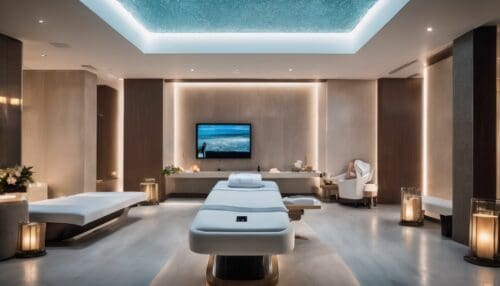Updated On: April 07, 2024 by dina
Luxury physical rehabilitation centres provide a unique approach to rehabilitation, catering to individuals who seek a higher level of comfort, privacy, and personalised care during their recovery process. These exclusive facilities offer a blend of top-tier medical services, opulent accommodations, gourmet dining, and various amenities to create an environment that promotes healing, relaxation, and overall well-being. While the costs associated with luxury rehabilitation centres can be significant, individuals who opt for such programs may find value in the enhanced experience, tailored treatments, and attention to detail these facilities provide.
Rehabilitation is a crucial aspect of healthcare, aimed at restoring function, promoting recovery, and improving the quality of life for individuals who have experienced injuries, surgeries, or illnesses. While traditional rehabilitation centres provide adequate care, some individuals may seek higher comfort, luxury, and personalised services during their recovery journey. This article will explore the concept of luxury rehabilitation, highlight notable examples of luxury rehabilitation centres, discuss the potential benefits and considerations, and delve into the associated costs.
What Is an Example of Physical Rehabilitation?
An example of physical rehabilitation is recovering from a knee injury through targeted exercises and therapies. Here’s a step-by-step example of what a physical rehabilitation program for a knee injury might involve:
- Initial assessment: A physical therapist evaluates the extent of the knee injury, considers strength, the range of motion, and the knee’s stability joint, and determines the specific needs of the patient.
- Pain management: If the patient is experiencing pain or inflammation, the therapist may employ techniques such as ice or heat therapy, electrical stimulation, or ultrasound to help reduce pain and swelling.
- Range of motion exercises: Gentle exercises and stretching are introduced to gradually improve the knee’s range of motion; this may involve bending and straightening the knee or performing controlled leg swings.
- Strengthening exercises: As the knee becomes more mobile, the therapist introduces strengthening exercises to improve muscle strength and the joints of the knee’s stability; this may require exercises such as leg presses, squats, or resistance band exercises.
- Balance and proprioception training: specific exercises are incorporated to improve proprioception (awareness of body position) and stability and enhance balance and coordination; this could involve standing on one leg, using a balance board, or performing exercises on unstable surfaces.
- Functional exercises: As the knee continues to heal, the focus shifts towards more functional movements and activities; this may involve exercises that mimic everyday activities like walking, climbing stairs, or squatting.
- Cardiovascular conditioning: If appropriate, cardiovascular exercises like cycling, swimming, or using an elliptical machine may be included to improve overall fitness and endurance.
- Gradual return to activities: The therapist works with the patient to gradually reintroduce activities specific to their lifestyle or sports participation; this involves closely monitoring the knee’s response and adjusting the rehabilitation program accordingly.
The physical therapist guides the rehabilitation process, monitors progress, and modifies the treatment plan as needed. The duration and intensity of the rehabilitation program may vary depending on the severity of the injury, individual factors, and the patient’s desired goals.
What Is the Meaning of Physical Rehabilitation?
Physical rehabilitation refers to restoring or improving a person’s physical function, mobility, strength, and overall well-being after an injury, illness, or surgery. Physical rehabilitation aims to optimise a person’s ability to perform daily activities and participate in desired activities, such as work, sports, or hobbies.
Physical rehabilitation can encompass various healthcare disciplines, including physical therapy, occupational therapy, and sports medicine. These professionals work together to assess, diagnose, and develop individualised treatment plans to address specific physical impairments or limitations.
Physical rehabilitation aims to help individuals regain independence, reduce pain, improve range of motion, increase muscle strength and flexibility, enhance balance and coordination, and promote overall physical fitness. It involves a combination of therapeutic exercises, manual techniques, modalities (such as heat or cold therapy and electrical stimulation), functional training, assistive devices, and patient education.
Physical rehabilitation is not limited to a particular area of the body. Still, it can address a wide range of conditions, including orthopaedic injuries (such as fractures, sprains, or joint replacements), neurological disorders (such as stroke, spinal cord injury, or multiple sclerosis), chronic pain conditions, cardiopulmonary conditions, and more.
The duration and intensity of physical rehabilitation may vary depending on the nature and severity of the condition, as well as the individual’s goals and progress. It often involves a progressive and personalised approach, where the treatment plan is regularly evaluated and adjusted to ensure the best possible outcomes for the patient.
What Is the Highest Level of Rehab?
The highest level of rehabilitation typically refers to comprehensive, specialised, and intensive rehabilitation programs provided at specialised rehabilitation hospitals or centres. These facilities have advanced medical technology, a multidisciplinary team of healthcare professionals, and specialised programs to address complex and severe medical conditions. The highest level of rehab is usually sought for individuals with significant impairments, disabilities, or functional limitations resulting from severe injuries, illnesses, or surgeries. Some examples of conditions that may require the highest level of rehab include:
- Traumatic brain injuries (TBI): Severe brain injuries resulting from accidents, falls, or other traumatic events may require intensive rehabilitation to address cognitive impairments, motor deficits, and functional limitations.
- Spinal cord injuries (SCI): Rehabilitation for individuals with spinal cord injuries involves addressing mobility, strength, independence, and adapting to a new lifestyle with a spinal cord injury.
- Stroke: Comprehensive rehabilitation is essential for individuals who have experienced a stroke to address motor, speech, and cognitive impairments and facilitate recovery and functional independence.
- Complex orthopaedic injuries: Severe fractures, multiple fractures, or extensive joint damage that require surgery and extended rehabilitation may necessitate the highest level of rehab to restore mobility, strength, and function.
- Neurological conditions: Progressive neurological conditions such as multiple sclerosis, Parkinson’s disease, or ALS may require specialised rehabilitation programs to manage symptoms, optimise function, and improve quality of life.
- Organ transplantation: Following organ transplantation, individuals may undergo intensive rehabilitation to regain strength, endurance, and overall function, particularly for activities related to the transplanted organ.
In the highest level of rehab settings, patients receive coordinated care from a team of healthcare professionals, including physicians, physical therapists, occupational therapists, speech-language pathologists, psychologists, social workers, and other specialists as needed. The programs focus on maximising functional abilities, promoting independence, enhancing the quality of life, and facilitating the transition back to home and community settings. The highest level of rehab may vary depending on the healthcare system, region, and available resources. Countries or regions may have varying specialised rehabilitation facilities and services.
What Are 3 Examples of Rehabilitation?
Many other types of rehabilitation programs are available to address various medical, physical, cognitive, or psychological conditions. Here are three examples of rehabilitation:
1. Cardiac Rehabilitation
Cardiac rehabilitation programs are designed to help individuals who have experienced undergone heart surgery, a heart attack, or have been diagnosed with heart disease. These programs typically involve supervised exercise, education on heart-healthy lifestyle choices, nutritional guidance, and emotional support. The goal is to improve cardiovascular fitness and reduce the risk of future heart problems.
2. Substance Abuse Rehabilitation
Substance abuse rehabilitation programs assist individuals in overcoming drug or alcohol addiction. These programs can take various forms, including inpatient or outpatient settings, and involve a combination of counselling, behavioural therapy, support groups, and medical interventions. The focus is helping individuals achieve sobriety, address underlying causes of addiction, develop coping mechanisms and rebuild their lives without substance abuse.
3. Vocational Rehabilitation
Vocational rehabilitation programs aim to assist individuals with disabilities or impairments in acquiring or regaining employment. These programs typically involve vocational assessments, career counselling, skills training, job placement assistance, and accommodations in the workplace. The goal is to enhance an individual’s ability to perform job-related tasks, improve employability, and promote independence and self-sufficiency in the workforce.
These are just three examples of rehabilitation. The specific type of rehabilitation needed will depend on the individual’s unique circumstances and goals.
What Are the Five Phases of Physical Rehabilitation?
Physical rehabilitation typically consists of five phases, commonly called the “continuum of care.” These phases help guide the progression of treatment and recovery. While the specifics may vary depending on the condition or injury, here are the five general phases of physical rehabilitation:
Phase 1: Acute/Early Phase
This initial phase begins immediately after the injury, surgery, or onset of the condition. The focus is reducing pain, swelling, and inflammation and protecting the injured area. Treatment may involve rest, immobilisation, pain management techniques, and gentle range of motion exercises. The goal is to initiate the healing process and prepare for the next rehabilitation phase.
Phase 2: Subacute/Intermediate Phase
In this phase, the emphasis shifts towards promoting healing, restoring function, and regaining mobility. Treatment includes therapeutic exercises, manual therapy, modalities, and targeted interventions based on the specific injury or condition. Strengthening exercises, flexibility training, and balance activities are gradually introduced. Patient self-care, activity modification, and injury prevention education are also incorporated.
Phase 3: Advanced/Functional Training Phase
As the patient’s condition improves, this phase focuses on restoring more complex movement patterns and functional abilities. The rehabilitation program includes activities and exercises that closely mimic the demands of daily activities, work, or sports participation. Intensive strengthening, endurance training, coordination, and balance activities are emphasised. Progression towards more challenging functional tasks and activities is tailored to the individual’s goals.
Phase 4: Return to Activity/Sport-Specific Phase
This phase is specific to individuals who aim to return to athletic or highly demanding physical activities. The focus is on preparing the individual for the particular needs of their sport or activity. Rehabilitation involves sport-specific training, skill development, agility drills, and sport-specific conditioning exercises. Gradual progression is followed, closely monitoring the individual’s readiness for full participation.
Phase 5: Maintenance/Preventive Phase
The final phase focuses on maintaining the gains achieved throughout rehabilitation and preventing future injuries or setbacks. Individuals receive home exercise programs, self-management strategies, and ongoing physical fitness and wellness guidance. Regular follow-up appointments or periodic check-ins may be scheduled to assess progress and address concerns. The duration and progression through these phases may vary depending on the individual’s condition, response to treatment, and specific goals. Rehabilitation programs are typically tailored to meet the individual needs of each patient.
What Is the Most Luxurious Physical Rehabilitation?
Luxury physical rehabilitation facilities provide a high-end and exclusive experience, combining top-notch medical care with luxurious amenities and personalised services. While the concept of luxury can vary, here are some examples of renowned and upscale physical rehabilitation centres known for their luxurious offerings:
1. The Kusnacht Practice, Switzerland
The Kusnacht Practice is Known for its exceptional privacy and personalised treatment, The Kusnacht Practice offers luxury rehabilitation services for individuals with addiction, mental health disorders, and other conditions. Their programs include individualised therapy, holistic treatments, personalised fitness programs, gourmet cuisine, and luxurious accommodations.
2. The Dunes East Hampton, United States
The Dunes East Hampton is Situated in the Hamptons, a prestigious resort area in New York, The Dunes East Hampton is a luxury rehab centre focusing on addiction and mental health treatment. It offers a serene and upscale environment with private rooms, gourmet meals, spa services, yoga classes, and personalised therapy.
3. The Kusnacht Practice, Caribbean
The Caribbean branch of The Kusnacht Practice is located on a private island in the Caribbean and provides a luxurious and exclusive setting for rehabilitation. Along with addiction and mental health treatment, it offers private beachfront villas, gourmet dining, personal trainers, and a wide range of wellness activities.
4. The Cabin Chiang Mai, Thailand
The Cabin Chiang Mai is Situated in a tranquil setting in northern Thailand, The Cabin Chiang Mai is a luxury rehab centre specialising in addiction treatment. It combines evidence-based therapies with luxurious accommodations, a holistic approach, gourmet meals, a spa, and recreational activities like Thai cooking classes and yoga.
5. The Priory Hospital, Roehampton, United Kingdom
: The Priory Hospital in Roehampton is known for its high-quality rehabilitation services for various mental health conditions, including addiction and eating disorders. The facility provides private rooms, gourmet dining, tailored therapy programs, a fitness centre, and beautiful gardens
Luxury rehabilitation centres often come with higher costs compared to traditional rehabilitation facilities. These facilities aim to provide a luxurious and comfortable environment to enhance the rehabilitation experience. However, the effectiveness of rehabilitation programs should be considered alongside the luxury amenities when choosing a rehabilitation centre.
How Much Do Luxury Rehabilitation Hospitals Cost?
The cost of luxury rehabilitation hospitals can vary significantly depending on several factors, including location, program duration, level of personalised care, amenities offered, and specific services required. Luxury rehabilitation centres generally come with higher price tags than standard rehabilitation facilities. As the costs can vary greatly, it is recommended to directly contact the rehabilitation hospitals of interest to obtain accurate and up-to-date pricing information. The facilities should be able to provide you with detailed information about their programs, services, and associated costs. Here are some of these factors that may influence the cost of luxury rehabilitation hospitals include:
- Location: Facilities in upscale areas or exotic destinations may have higher costs due to their prime location and associated expenses.
- Duration of the Program: Longer programs typically entail higher costs than shorter stays. The rehabilitation programs can range from a few weeks to several months.
- Level of Personalised Care: Luxury rehabilitation centres often provide highly personalised care, including one-on-one therapy sessions, dedicated staff, and individualised treatment plans. These additional services can contribute to higher costs.
- Amenities and Services: The inclusion of luxurious amenities such as private accommodations, gourmet dining, spa services, recreational activities, and specialised therapies can significantly impact the overall cost.
- Additional Services: Some rehabilitation centres may offer additional services like medical detoxification, alternative therapies, psychological assessments, and aftercare programs, which can affect the overall cost.
Due to the specialised nature of luxury rehabilitation centres and the personalised approach they offer, the costs can be substantial. It’s advisable to thoroughly research and consider different options while considering your specific needs, budget, and desired level of care. Additionally, checking if any insurance coverage or financial assistance options are available can help offset the expenses.
Ultimately, the decision to pursue luxury rehabilitation should be based on personal preferences, financial considerations, and the specific needs of the individual seeking rehabilitation. It is essential to research and explores various options thoroughly, considering the centres’ expertise, track record, and reputation while considering the overall goal of achieving successful rehabilitation and long-term well-being. Luxury physical rehabilitation centres have emerged as exclusive and luxury settings that combine world-class medical care with lavish amenities, creating an environment that caters to patients’ physical and emotional well-being. These facilities go beyond the standard rehabilitation experience, offering privacy, tranquillity, and a range of luxurious offerings to enhance the recovery process.











